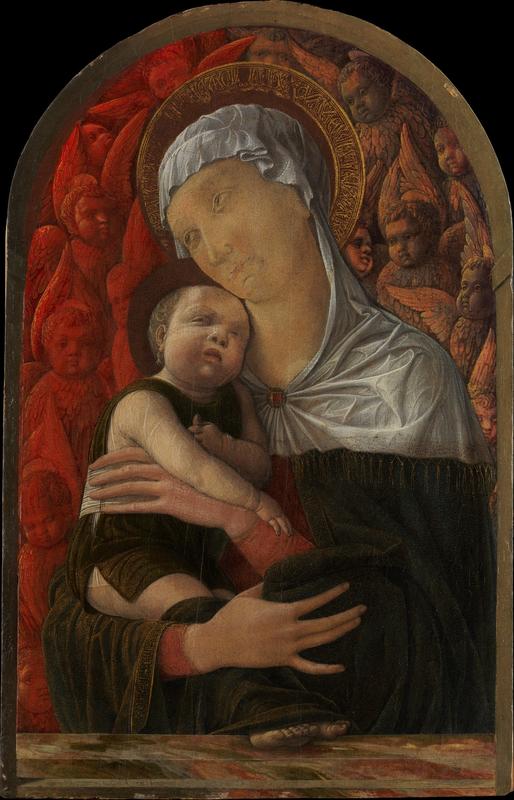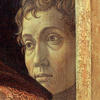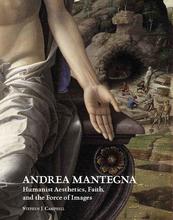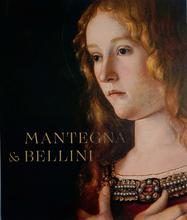More about Madonna and Child with Seraphim and Cherubim
- All
- Info
- Shop

Sr. Contributor
If you’ve seen one Madonna and Child, you’ve pretty much seen ‘em all.
The Christ child depicted with the Virgin Mary is one of the foundational images of Western art and has developed a long visual tradition. Because everyone was pretty much only painting pictures of Jesus, artists had to figure out ways to make their paintings stand out from all the others. As one of the forerunners of Italian Renaissance painting, Andrea Mantegna was early to this party.
Growing up near Padua, Mantegna couldn’t escape the influence of master sculptor Donatello, who lived and worked there for a decade starting in 1443. It wasn’t long before Mantegna developed a bulky, sculptural painting style. This unique style helped Mantegna to develop volumetric forms and lent his work a heightened sense of illusion, which he also played up with tricks. Here, he sets the figures within what looks like a painted niche in a marble archway. Mantenga also cleverly set a cloth over the baby’s legs to make them seem as though they are receding into the picture plane.
Mantegna also added red seraphim and lavender cherubim, two kinds of Biblical angels, to this image. Although you may have never heard of them, seraphim were pervasive in Medieval Christian theology, and they appeared in the work of other artists. For instance, Giotto painted an image of Saint Francis experiencing a vision of a seraph. Seraphim first appeared in the Torah and then in the Bible. In the Christian ranking of types of angels, a practice called angelology, seraphim are the highest-ranked angels. Judaism must be hardcore because seraphim only rank fifth in the ten types of Hebrew angels.
Although the figures on the right look cute and cuddly, the Bible describes cherubim as winged beings with four different faces: a man, an ox, a lion, and an eagle. Despite their more menacing beginnings, cherubs in Western Medieval art quickly became associated with 'putti', or the cute, chubby babies with wings that we see in this painting.
If you can direct your attention away from the creepy babies that comprise the background, you’ll notice that the faces of Christ and the Virgin Mary are pretty jacked up. This isn’t entirely Mantegna’s fault. The painting had suffered damage and years of bad reconstructions when the Met bought it from Michael Friedsam, a New York philanthropist and former president of the B. Altman and Company department store, in 1931. Mantegnas weren’t the only great works that Friedsam had. By the time he died, he had amassed a pretty serious art collection, including works by Vermeer, van Eyck, and more. He ended up donating his collection, splitting it between the Met and the Brooklyn Museum.
However, Brooklyn Museum curators don’t exactly want some of Friedsam’s works anymore. Although there are some excellent pieces in the collection, others are either not of museum quality or are outright forgeries. But, because of the wording of the contract that dictated this large bequest, curators are having a hard time getting rid of the unwanted pieces.
Sources
- Miller, Charisma. “Man who gave Brooklyn Museum restricted gifts in 1930s leaves no heirs, so Surrogate Court to decide outcome.” The Brooklyn Daily Eagle. 5 Feb 2013. https://brooklyneagle.com/articles/2013/02/05/man-who-gave-brooklyn-mus…-
- Sorabella, Jean. “The Birth and Infancy of Christ in Italian Painting.” The Heilbrunn Timeline of Art History. The Metropolitan Museum of Art. June 2008. https://www.metmuseum.org/toah/hd/birt/hd_birt.htm. Accessed 23 June 2019.
- The Metropolitan Museum of Art. “Madonna and Child with Seraphim and Cherubim.” Collection. https://www.metmuseum.org/art/collection/search/436968. Accessed 23 June 2019.
- Wikipedia. “Cherubim.” https://en.wikipedia.org/wiki/Cherub. Accessed 23 June 2019.
- Wikipedia. “Christian angelology.” https://en.wikipedia.org/wiki/Christian_angelology. Accessed 23 June 2019.
- Wikipedia. “Seraph.” https://en.wikipedia.org/wiki/Seraph. Accessed 23 June 2019.
Featured Content
Here is what Wikipedia says about Butler Madonna
The Butler Madonna or Madonna and Child with Cherubim and Seraphim is a tempera on panel painting measuring 44.1 by 28.6 cm. It is attributed to Andrea Mantegna, dated to around 1460. Its poor conservation, including over-harsh restoration to Mary's face, means that some art historians cannot accept it as an autograph work and theorise that it was produced by a follower of Mantegna after an autograph original. Its provenance is unknown before 1891, when it appeared for sale at a London art dealer. It was purchased by Charles Butler, from whom it passed to the Metropolitan Museum of Art in New York in 1926, where it still hangs.
If it is an autograph work, it dates from after Mantegna's trip to Rome and some attribute it to the end of his Paduan period (c.1460), suggested by comparison with the Presentation at the Temple, which has similar fictive marble frame in the foreground. It belongs to a group of small-format Madonnas produced by Mantegna for private devotion - others include Madonna with Sleeping Child (Berlin), the Poldi Pezzoli Madonna and the Bergamo Madonna. The cherubim are in blue and the seraphim in red, whilst the painter has drawn on Donatello's example in showing Mary incline her face towards her son.
Check out the full Wikipedia article about Butler Madonna














